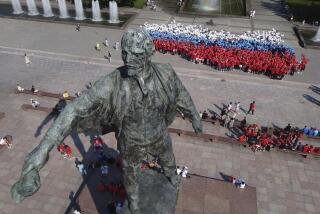The Legacies of Hubris
- Share via
The Russians people are proud of the ships they deployed, the tall towers they built and the achievements that gave the now-defunct Soviet Union a superpower status. Now, however, their symbols are the mangled carcass of the submarine Kursk, resting at the bottom of the Barents Sea with all hands lost, and the burned-out hulk of Moscow’s Ostankino TV Tower. These disasters mock Vladimir V. Putin’s illusions of presiding over a world power.
Muscovites watched in horror and despair as the 1,771-foot tower, built in 1967 to mark half a century of Communist rule, burned out of control. Its architects wanted the tower to stand as a symbol of Soviet engineering prowess and their technological genius. It succumbed to shoddy workmanship, poor maintenance and under-funding.
What caused the Aug. 12 sinking of the Kursk, the pride of Russia’s naval forces, remains to be determined. But the handling of the tragedy by Moscow officials bears all the hallmarks and hubris of “the Soviet man,” the Communist hero worker whose exploits were glorified in posters hailing his achievements in agriculture and engineering marvels. It didn’t matter what the actual grain harvest shortfall or construction defects were. The Russians were rightfully boastful of raising their empire into a 20th century powerhouse, but the deep faults of its foundation now lie exposed.
Officials kept the Kursk incident under wraps for days and then lied about everything, even the most trivial details. Putin didn’t bother to interrupt his vacation to attend to the rescue efforts, perhaps because he was among the few who knew enough to believe them futile. At least with the Kursk, unlike previous disasters and calamities kept secret, the sinking has been debated in public and the authorities are under pressure to take responsibility.
These are the legacies of the Soviet man: An economy in shambles, widespread corruption, a devastated environment, a decrepit health system and human misery across 11 time zones. The August disasters do not even begin to describe the extent of Russia’s problems, but they are significant because they toppled some of the most powerful symbols of Russian pride.
Putin was right when he told his Cabinet in an emergency meeting after the Ostankino tower blaze: “This emergency highlights what condition vital facilities, as well as the entire nation, are in.” A hard and humbling recognition, but one Putin had to make before improvement can begin.
More to Read
Sign up for Essential California
The most important California stories and recommendations in your inbox every morning.
You may occasionally receive promotional content from the Los Angeles Times.













